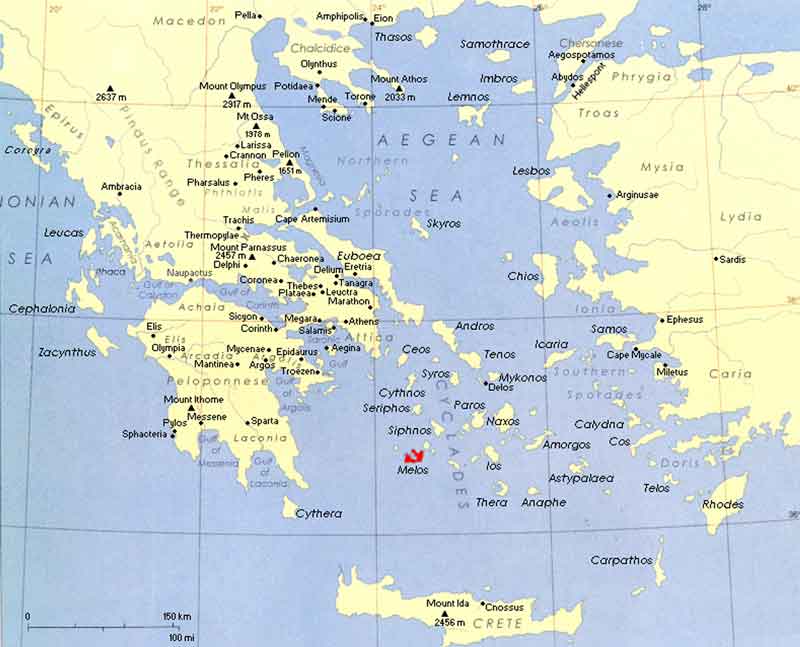
Melos
An island in the Aegaean Sea, the most westerly of the Cyclades. It was first colonized by the Poenicians, who called it Byblos or Byblis, and afterwards by the Lacedaemonians, or at least by Dorians. Hence, in the Peloponnesian War, it embraced the side of Sparta.
The position of Melos, between Greece and Crete, and its possession of obsidian, made it an important centre of early Aegean civilization. At the well-known Bronze Age site of Phylakopi, the chief settlement, on the north-east coast. Excavations of the British school revealed a Minoan palace and a town wall. Part of the site has been washed away by the sea. The antiquities found were of three main periods, all preceding the Mycenean age of Greece. Much pottery was found, including examples of a peculiar style, with decorative designs, mostly floral, and also considerable deposits of obsidian. There are some traditions of a Phoenician occupation of Milos.
In historical times the island was occupied by Dorians from Laconia. In the 6th century BC it again produced a remarkable series of vases, of large size, with mythological subjects and orientalizing ornamentation, and also a series of terra-cotta reliefs.
Though Melos inhabitants sent a contingent to the Greek fleet at Salamis Island, it held aloof from the Delian League, and sought to remain neutral during the Peloponnesian War.
In 416 an Athenian force beseiged the tiny city-state on the island of Melos situated in the Mediterranean south of the Peloponnese, a community sympathetic to Sparta that had taken no active part in the war, although it may have made a monetary contribution to the Spartan war effort. In any case, that Athens considered Melos an enemy had been made clear earlier when Nicias had led an unsuccessful attack on the island in 426. Now once again Athens in 416 demanded that Melos support its alliance voluntarily or face destruction, but the Melians refused to submit despite the overwhelming superiority of Athenian force. When Melos eventually had to surrender to the beseiging army, its men were killed and its women and children sold into slavery. An Athenian community was then established on the island. Thucydides portrays Athenian motives in the affair of Melos as concerned exclusively with the amoral politics of the use of force, while the Melians he shows as relying on a concept of justice to govern relations between states. He represents the leaders of the opposing sides as participating in a private meeting to discuss their views of what issues are at stake. This passage in his history, called the Melian Dialogue, offers a chillingly realistic insight into the clash between ethics and power in international politics. The length of the island is about fourteen miles from east to west, and its breadth from north to south eight miles.
In 1820, among the ruins of the ancient city of Melos near the theatre was found the exquisite statue usually called the Venus of Milo (Venere di Milo), now in the Louvre at Paris, having been purchased by the Marquis de Rivière, and by him presented to Louis XVIII. It is composed of two blocks of marble, which unite just above the garment which covers the legs. (From Perseus and Harpers Dictionary of Classical Antiquities, 1898)